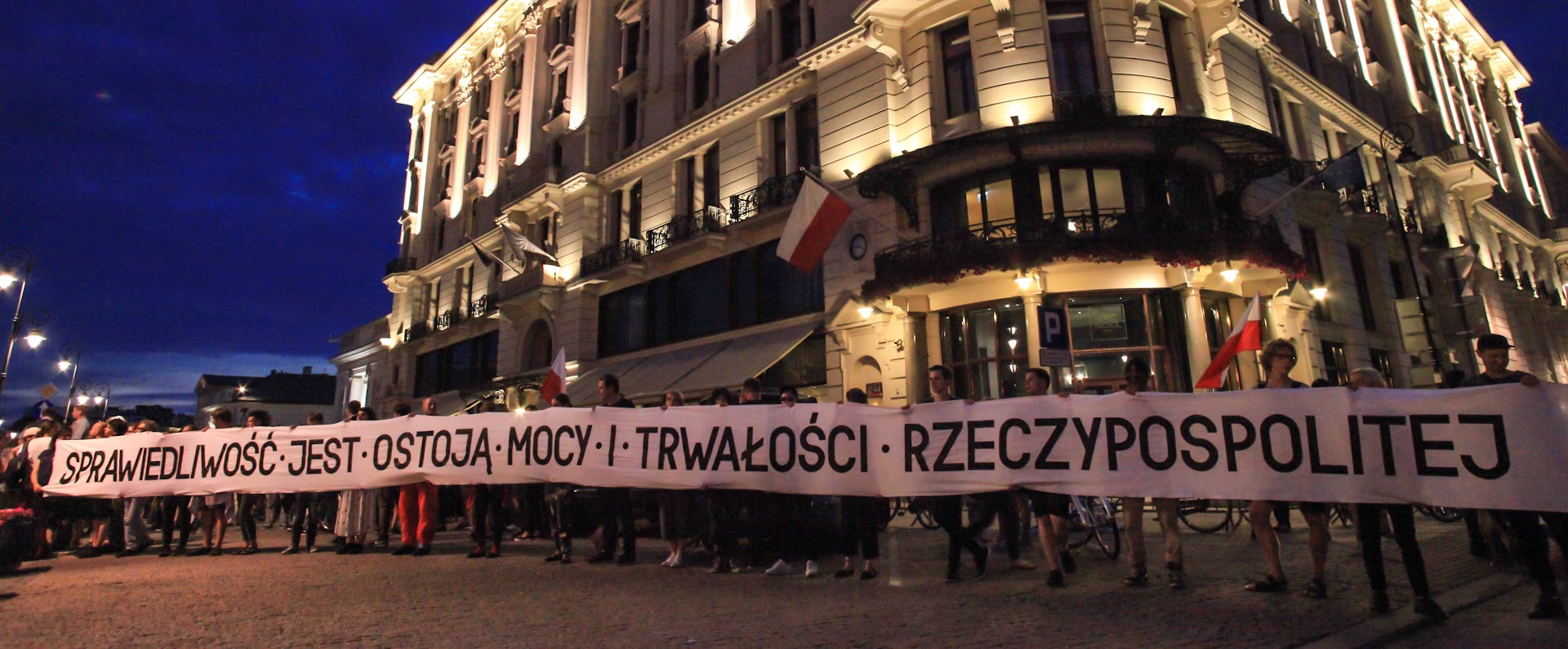Minds of the Movement
An ICNC blog on the people and power of civil resistance
by Marcin MrowickiMay 12, 2025
During a three-year judicial training in Poland, I was taught how to deal with different cases as a judge. I had to pass a very difficult judicial exam knowing all Supreme Court case law in criminal and civil law. Nobody, however, taught me how to deal with populists, how to defend judicial independence, or how to communicate with the public in accessible language.
Much less how to combat politicians’ lies and their attacks on courts.
For generations, the image of a judge in many countries has been shaped by formality, discretion and distance. Judges are trained to be neutral, nearly invisible arbiters of the law, not participants in public debate or defenders of democracy. But when the ruling party of my country began systematically undermining judicial independence starting in 2015, that model cracked. What emerged in its place is a quiet but powerful reinvention of the judicial role—one that is digital, communal and sometimes even theatrical.
Two efforts stand out as especially transformative: the development of encrypted, nationwide communication networks between judges, and grassroots public education through citizen engagement. These are not just symbolic acts. They are strategic responses to democratic backsliding and information warfare.
1. Secure messaging, shared nonviolent resistance: How judges built a digital lifeline
When Poland’s government captured the Constitutional Tribunal, most judges remained silent. But the real alarm came with a suite of laws designed to bring the entire judiciary under executive control. That’s when many judges realized they could no longer rely on institutional protocols or traditional neutrality—they had to organize. And they had to do it securely.
Today, dozens of encrypted communication groups span platforms like WhatsApp, Signal, ProtonMail and Viber. These aren't just informal chat threads. They’re vital infrastructure for organizing nonviolent resistance, sharing legal documents, coordinating public statements and sending support to persecuted colleagues.
Judge 1 described the scale: “Our communication network is huge. We have several dozen groups on different social media platforms.” A single message, once confined to quiet discussions at a court in Warsaw, can now reach judges across Poland in minutes. “Thanks to this, a document issued by the president of the court can cover the whole of Poland in a few minutes,” said Judge 4.

Credit: Paweł Rochowicz.
Speed, solidarity and security define these digital channels. They are also a protective mechanism in a climate where judges face disciplinary actions, criminal investigations and surveillance simply for defending the rule of law. Judges share scans of prosecutor letters, promotional materials and updates about legal assemblies or casual gatherings. Through encrypted tools, they’ve built not just a communication network, but a decentralized resistance.
Common sense is crucial in operating these communication groups. Participation should be on a need-to-know basis. A small and trusted number of group participants (administrators) should be responsible for verifying, adding and removing contacts. Verification is based on participant confirmation that a new member is trustworthy, takes part in nonviolent resistance and is known to the person who is recommending them.

Credit: Paweł Rochowicz.
2. Theater, festivals and fairytales: Reclaiming the judiciary in the public eye
If secure networks are the nervous system of the movement, then public education is its soul. Polish judges quickly realized that legal expertise and moral authority weren’t enough if the public didn't understand—or care—what was at stake. So, they stepped out of the courtroom and into community spaces, festival tents and schoolyards.
One of the most striking tools? Mock trials.
At the 2022 Open’er Festival, judges simulated trials including the now-famous Trial of the Wolf and Little Red Riding Hood, drawing crowds of festivalgoers to engage with ideas of justice, rights and power in a fun, accessible way. These performances helped translate complex legal principles into relatable stories. A fairy tale becomes a classroom; a festival becomes a courtroom.

Credit: Paweł Rochowicz.
Workshops, quizzes on the constitution, open debates held at major events like PolAndRock Festival and CieszFanów, informal talks organized at the local cafe … all created space for real conversations about civil liberties and judicial independence. At these events, judges were no longer distant figures in robes; they were educators, defenders and sometimes even performers.
These actions were not one-off publicity stunts. They were deliberate efforts to rebuild trust and legitimacy through proximity. “We realized very quickly that we had to go beyond certain patterns,” said Judge 2. “The authorities wanted to isolate the courts from the people… It was necessary to get closer to people through various forms.”
That proximity paid off. Citizens who might once have felt alienated from the legal system began showing up to demonstrations, talking about the constitution and seeing judges as allies, not elites. “They are your judges,” activists would say, introducing local magistrates to their communities.
From isolation to engagement
The Polish judiciary’s transformation is a case study in adaptive democracy. Under threat, judges could have retreated further into legalism and formality. Instead, they chose connection—digitally, socially and educationally.
Encrypted communication groups have become lifelines of mutual aid and coordinated action. Public plays and festival workshops have become tools of civic awakening. Together, they form a dual strategy that does more than resist authoritarianism; it rebuilds the relationship between courts and citizens from the ground up.
In an era where democratic institutions are under assault across the globe, these two quiet revolutions—secure communication and creative public engagement—offer a roadmap for how to defend the rule of law not just in courtrooms, but in hearts and minds.

Marcin Mrowicki
Marcin Mrowicki, PhD, is Assistant Professor of EU Law and Human Rights at the University of Warsaw (Centre for Europe). He is an author of many academic and popular science publications, including All Rise: Judicial Resistance in Poland (ICNC Press, 2024).
Read More